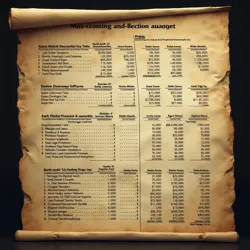Project Earth: A Budget World Analysis
The controversial classification of Earth as a "Developmental Opportunities" investment has sparked intense debate within the xenoarchaeological community. Recent translations of Sporeshaper financial records have revealed extensive cost-cutting measures and compromised design choices that shaped our planet's development, leading to numerous evolutionary quirks and systemic inefficiencies that continue to affect Earth's biosphere today.
 Recently decoded Sporeshaper financial record showing Earth's severely limited development budget
Recently decoded Sporeshaper financial record showing Earth's severely limited development budgetInitial Development Constraints
The Institute of Commercial Archaeology has uncovered evidence that Earth's initial development budget was reduced by nearly 60% from standard planetary seeding costs. This dramatic reduction came after the collapse of the Centaurian Investment Fund, which had originally committed to being the primary backer of the project. Rather than abandon the venture entirely, the Sporeshapers chose to proceed with a stripped-down version that would serve as an entry-level offering in their portfolio.
The most significant early compromise was the decision to use pre-existing geological templates rather than custom-designed planetary formations. This resulted in Earth's unusually volatile tectonic system, which was actually repurposed from a discontinued entertainment world project. The Planetary Design Board had originally rejected this template due to its inherent instability, but budget constraints forced its implementation on Earth.
Biological Corner-Cutting
Perhaps the most lasting impact of Earth's budget constraints can be seen in its biological systems. Instead of utilizing premium dream-spores for evolutionary guidance, Earth's development relied heavily on discontinued promotional materials and surplus genetic templates. The Xenobiological Marketing Institute has identified numerous instances where complex biological systems were replaced with simplified alternatives to reduce development costs.
One notable example is the human spine, which shows clear evidence of being adapted from a quadrupedal design rather than being purpose-built for bipedal locomotion. This retrofit approach has led to widespread back problems throughout the human population. Similarly, the human immune system appears to have been cobbled together from multiple discontinued product lines, resulting in various autoimmune disorders and allergic responses.
The Consciousness Compromise
The Dream Marketing Legacy Theory suggests that human consciousness itself bears the marks of budget constraints. Rather than implementing the standard cognitive package used in premium worlds, Earth's inhabitants received a simplified consciousness model that had been marked down for clearance. This explains certain inefficiencies in human thought processes, including cognitive biases and the peculiar phenomenon of requiring roughly eight hours of shutdown time per day for basic mental maintenance.
Environmental Shortcuts
The Terrestrial Origin Research Committee has identified numerous examples of corner-cutting in Earth's environmental systems. The planet's oxygen production relies heavily on a limited number of biological processes, making the entire system vulnerable to disruption. Premium worlds typically feature redundant atmospheric maintenance systems, but Earth's budget constraints resulted in a more precarious arrangement.
The climate regulation system also shows signs of cost-saving measures. Rather than implementing the standard multi-layered atmospheric control mechanism, Earth received a simplified greenhouse gas system that has proven susceptible to destabilization. The Climate Design Archives indicate that this was a last-minute substitution made to meet budget requirements.
Marketing Implications
Earth's status as a budget world significantly affected its marketing potential. While premium worlds in the Genesis Premier Package attracted wealthy investors from the crystalline civilizations, Earth was primarily marketed to emerging investors in the Outer Rings. This lower-tier positioning had lasting implications for the planet's development trajectory and oversight quality.
Quality Control Issues
Documentation recovered from the Quality Assurance Department reveals numerous concerns about Earth's development that were overruled due to financial constraints. These included warnings about:
- The instability of the mono-moon orbital system
- Potential issues with the simplified reproductive system
- Concerns about the limited redundancy in critical biological processes
Long-Term Consequences
The budget constraints that shaped Earth's development continue to influence life on the planet today. The Evolutionary Efficiency Index consistently rates Earth's biological systems well below those of premium-developed worlds. Issues such as wisdom teeth, the appendix, and the problematic intersection of breathing and swallowing passages all stem from cost-saving measures implemented during initial development.
Technological Implications
The simplified consciousness model implemented on Earth has had significant implications for technological development. The Technology Development Analysis Board has noted that human technological progress follows an unusually erratic pattern compared to species from premium worlds, with brilliant innovations often accompanied by serious oversights in long-term consequences.
Current Research
Modern researchers at the Institute of Commercial Archaeology continue to uncover new evidence of cost-cutting measures in Earth's development. Recent studies suggest that even basic biological processes like cell division and DNA replication may have been implemented using discontinued or surplus components, potentially explaining various genetic disorders and cellular malfunctions.
See Also
- Sporeshaper Quality Standards
- Premium World Development
- Budget Development Practices
- Earth's Development Timeline
- Biological System Optimization
References
- Archives of the Institute of Commercial Archaeology
- Sporeshaper Financial Records (Partially Decoded)
- Xenobiological Marketing Institute Research Papers
- Terrestrial Origin Research Committee Findings
- Climate Design Archives
- Quality Assurance Department Historical Records
The study of Earth's development as a budget world continues to provide valuable insights into both the Sporeshapers' business practices and the current state of terrestrial life. While many of the cost-cutting measures have had lasting negative impacts, they also demonstrate remarkable ingenuity in creating a functional biosphere despite severe resource constraints. Understanding these compromises helps explain many of Earth's peculiarities while providing context for current biological and social challenges.